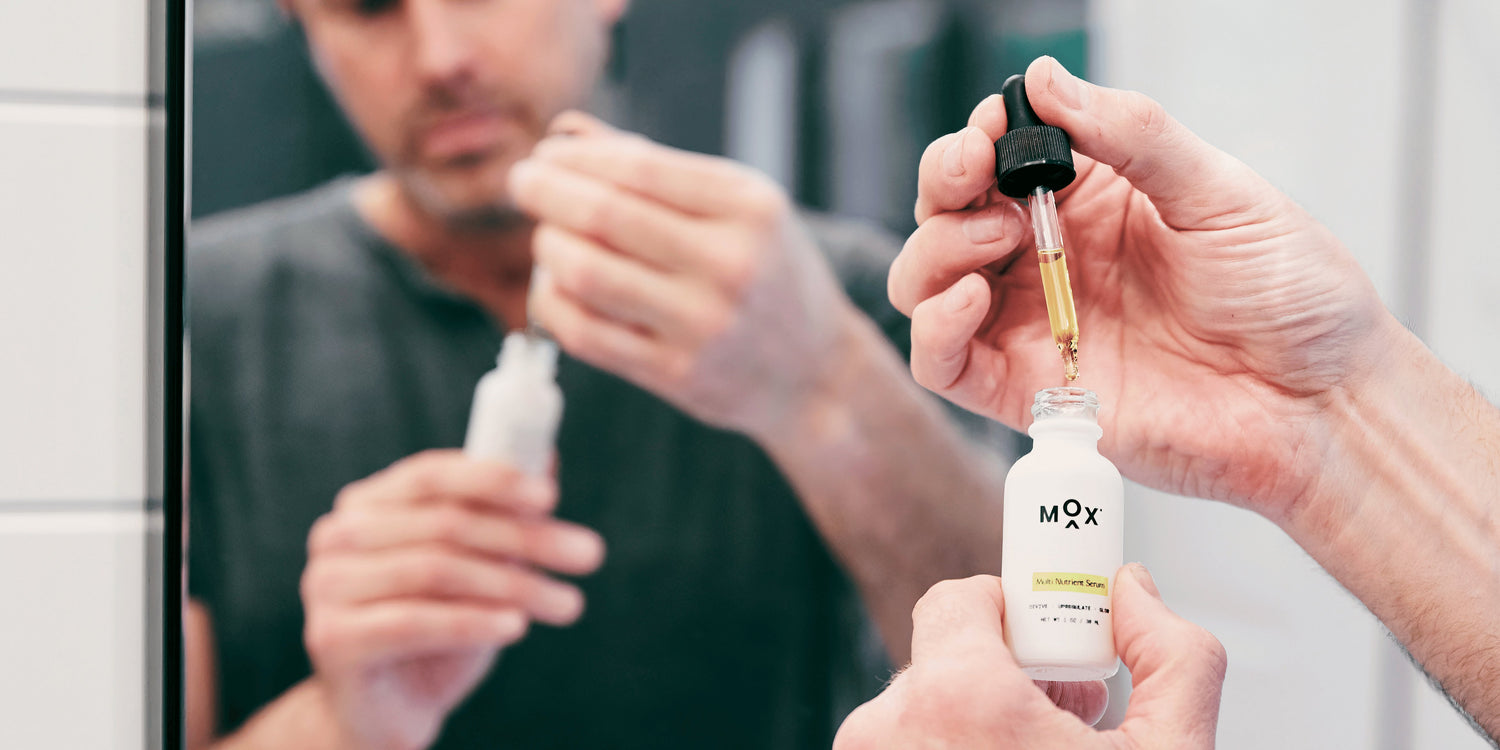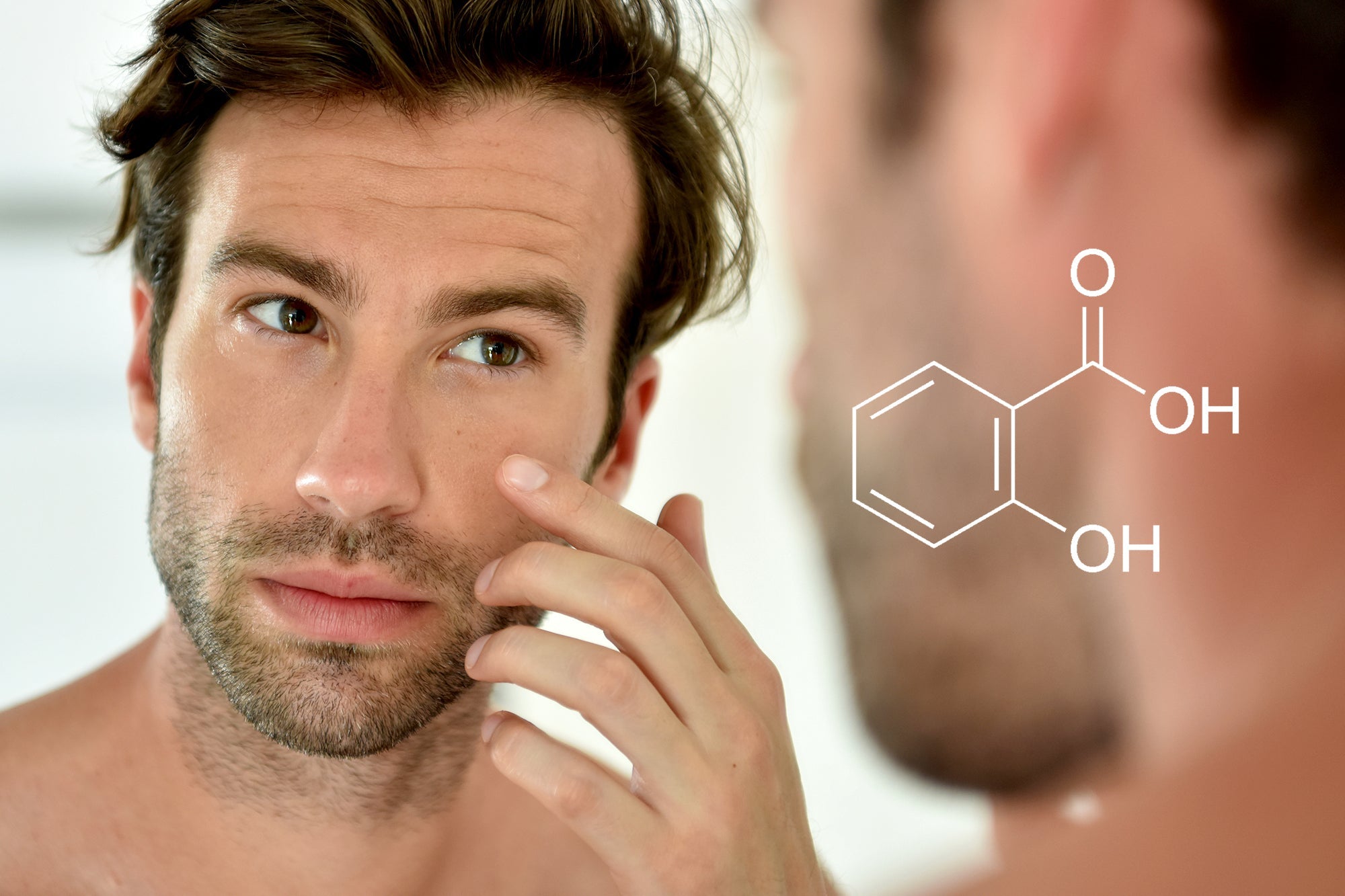The world of men’s face care is confusing as hell, especially when all these brands are throwing different products at us expecting our skincare routines to continue growing in steps. This is all because – as guys – we’re no longer limited to Speed Stick, waxy bar soaps, and VO5 to take care of our skin. Instead, the men’s grooming market is expanding, providing us with real formulations that can actually strengthen our skin, not contribute to the formation of things like wrinkles, acne, and dry skin. But do you know what all these new, guy-centric products do?
To help you better understand men’s face care, we’re going into the ring to decide which one your skin needs more: moisturizer vs. serum. Is there a difference between a serum and a moisturizer? What makes a serum better for men’s skin? Battle it out with MOX:
Exploring the Difference Between a Serum and a Moisturizer with MOX: What Are They?
You’ve likely seen both moisturizers and serums when shopping for new face care products, or you’ve noticed your wife slathering up her skin with both before taking on her day. But is there a difference between a serum and a moisturizer? Do you need both?
Here’s an intro into the whole moisturizer vs. serum debate:
What Is a Serum?

Serums are:
- Lightweight, fast-absorbing, and highly concentrated
- Typically contain a high concentration of active ingredients such as vitamins, antioxidants, hyaluronic acid, and peptides
- Formulated to address specific skin concerns because of the active ingredients, such as fine lines, wrinkles, dark spots, acne, or hydration
- Designed to penetrate deeply into your skin (sometimes on a cellular level) to deliver these active ingredients effectively
- Often used after a cleanser and toner but before moisturizer
Think of a serum like the vitamins you add to your protein shake before hitting the gym; they’re highly concentrated and promise to get you results quickly and effectively. Serums tend to have a slightly gooey consistency, but they’re normally quick-drying because they’re comprised of small molecules. This also allows your skin to soak them and their vitamins up really fast.
What Is a Moisturizer?

Moisturizers are:
- Also known as a cream or lotion
- Designed to hydrate and lock in moisture in the outermost layer of your skin (AKA the stratum corneum)
- Commonly formulated with a combo of ingredients such as emollients (fats and oils), humectants (attract and retain moisture), and occlusives (prevent water loss)
- Used to maintain your skin's moisture balance, prevent dryness, and create a protective barrier against environmental factors like harsh weather, pollutants, and irritants
- Often used as the final step in a face care routine to seal in the benefits of previous products, while also keeping your skin hydrated throughout the day or night
A Deeper Look At the Difference Between a Serum and a Moisturizer with MOX
 Pictured: The Difference Between a Serum and a Moisturizer
Pictured: The Difference Between a Serum and a Moisturizer
Before choosing a side in the battle of moisturizer vs. serum, it’s important to know that both are helpful for your skin. However, the face care benefits of serums far outweigh moisturizers as they can pump your skin with strengthening ingredients by working at a cellular level.
Here’s a deeper look at the difference between a serum and a moisturizer:
Consistency and Texture:
- Serums are typically lightweight and have a thinner consistency; they’re designed to be easily absorbed by your skin, leaving a non-greasy or tacky feel
- Moisturizers come in various textures, including creams, lotions, and thicker formulations, which create a barrier on your skin's surface
Concentration of Active Ingredients:
- Serums contain a high concentration of active ingredients (mentioned above), which allows them to address specific face care concerns by penetrating your skin
- While moisturizers may contain some active ingredients, their primary purpose is to hydrate and lock in moisture
Function:
- Serums are targeted treatments; they’re formulated to address specific face care concerns, making them ideal for treating things like aging, hyperpigmentation, and hydration at a deeper level
- Moisturizers primarily focus on providing hydration and maintaining your skin's moisture barrier; they help prevent water loss from your skin's surface by creating a protective layer
Use in a Skincare Routine:
- Serums are usually applied after cleansing and toning but before applying a moisturizer; since serums are generally filled with lots of active ingredients, you only need a few drops a day to see benefits
- Moisturizers are typically used as the final step in a face care routine to seal in moisture and protect your skin; they can be applied throughout the day as needed
Skin Type:
- Serums are suitable for most skin types, including oily, combination, and dry skin, depending on their specific formulation and active ingredients
- Moisturizers are essential for all skin types as they help maintain your skin's natural moisture balance
The Difference Between a Serum and a Moisturizer with MOX: The Active Ingredients in Serums
If you’re reading this thinking – “Damn, face care ingredients are confusing as hell” – then you’re not alone. It’s true; there are so many that it’s hard to know what they all do or why we even use them. But when it comes to the active ingredients in serums, it can be even more tricky because some have side effects that could potentially cause irritation or even a sensitivity to UV rays.
Here’s a chart on the active ingredients commonly used in serums to keep you in the know:

Should Serum or Moisturizer Be Applied First?
The reason why a serum can be applied first is because moisturizers contain ingredients that trap moisture in your skin, while also stopping other good ingredients from penetrating. This means putting a serum on over a moisturizer could stop you from reaping the serum’s benefits.
But – there is a face care loophole here: If you want to decrease the potency of your serum because it contains potentially irritating ingredients like retinol or salicylic acid (moderation is key!) then applying a moisturizer first could make the serum less potent and less irritating.
Experts refer to this technique as the “retinol sandwich,” which is where you apply moisturizer under and over retinol to lessen the effect. It’s important to know that the retinol sandwich isn’t useful for other ingredients in serums like hyaluronic acid, niacinamide, and vitamin C.
In fact, for most of these ingredients (and others in serums), you ideally want them to go as deep as possible for a health boost. If you’re using a potentially irritating serum, though, buffer its effects with a moisturizer before and after, otherwise – serums always get the driver’s seat.
The Difference Between a Serum and a Moisturizer with MOX: Ingredients NOT to Mix
Some ingredients in face care don’t jive together. For example, retinoids and exfoliants shouldn’t be mixed, while retinoids and benzoyl peroxide also don’t get along. Here’s why:
Retinoids – if you’re new to the whole face care thing – are intense treatments that can cause side effects like irritation. Using acid exfoliants on top of retinol can be too much for many people’s skin, which is completely normal. Plus, they can both increase your sun sensitivity.
Layering retinoids and benzoyl peroxide can cause your skin to dry out. This is because some studies have found that retinoids may disable benzoyl peroxide, while others haven’t. The consensus is a mixed bag, but it’s better to stay safe than sorry or ask your doctor first.
Meet the MOX Multi Nutrient Serum: A Serum and Moisturizer In One That Can Strengthen Men’s Skin
Cool Fact: The MOX Multi Nutrient Serum Is Packed With 20 to 40 Times More Nutrients Than a Traditional Serum

At MOX, we know that taking care of your skin with good-quality face care is crucial to a smooth, young-looking appearance. Our products are formulated by Pharmacist and Nutritionist Ben Fuchs, who uses his expertise to infuse each MOX product with vitamins, minerals, and other good-for-you ingredients like Squalane, lipids, electrolytes, and peppermint oil to feed and exercise your skin from within.

The MOX Multi Nutrient Serum, which is brimming with five-star reviews, serves as both a serum and moisturizer in one. It’s clinically proven to build collagen, improve strength, and increase moisture because of its robust ingredient list. The secret to this serum is simple: skin science. Since your skin needs and recognizes nutrients, MOX infused skin-energizing vitamins and nutrients into every drop of the serum, leaving men with healthy, replenished skin.
Grab the MOX Multi Nutrient Serum and harness the power of good face care (or grab it as a gift for someone you know). And don’t forget – (for those of you who were wondering what the difference between a serum and a moisturizer is) in the battle of moisturizer vs. serum, one thing remains true: Serums penetrate your skin deeper than a moisturizer, providing you with strong benefits and tough skin that can take on anything.
But thankfully – with the MOX Serum – you get both a serum and moisturizer in one, meaning fewer steps and more benefits. And make sure to tell us (now that you know) -- what's the difference between a serum and a moisturizer?




Leave a comment
This site is protected by hCaptcha and the hCaptcha Privacy Policy and Terms of Service apply.